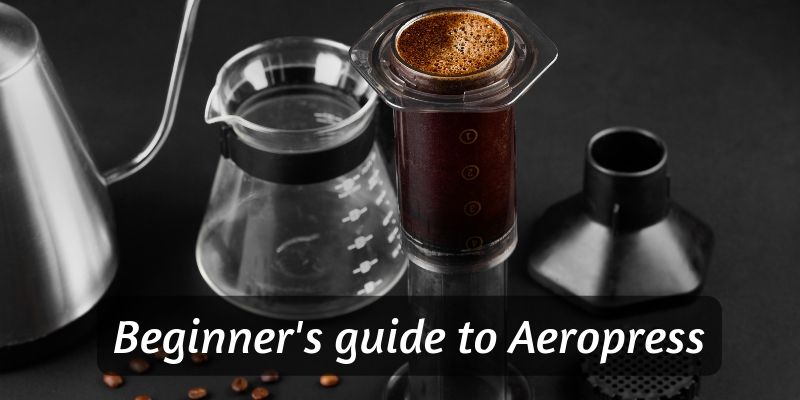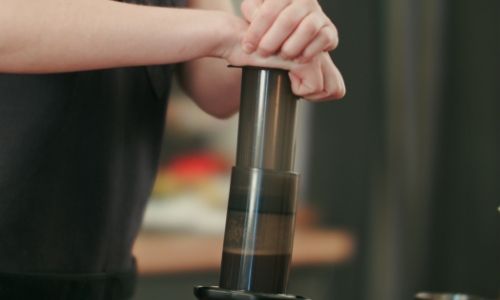Aeropress has taken the world by storm, and by now you've probably at least heard of it, if not already see one of those coffee makers.
As with any coffee brewing method, finesse and attention to detail is key. Which is why a guide, especially for the uninitiated, is going to be a good base to build your learning and love of coffee on.
Enjoy, and I hope this Aeropress guide will help you get the best coffee ever !
Table of Contents
What is Aeropress coffee ?
Aeropress coffee is made by using the Aeropress coffee makers. That is a plastic tube, within another tube, with a silicone filter at one end. The Aeropress can make coffee very similar to an espresso, but it's all in how you use it.
You can easily brew something very similar to filter coffee, or French press coffee in an Aeropress. It depends on how long you let the coffee steep, and also what you're looking to achieve.
How does the Aeropresso work ?
The Aeropress looks a bit like an oversized syringe, minus the needle. The inner tube is meant to quite literally push the coffee out through the silicone filter, as a syringe's plunger would.
There's also small paper filters, and they're meant to give you the cleanest cup of coffee possible.
This coffee maker works by using vacuum seals. Once you've got the coffee and the water into the tube, applying the inner tube will create an airtight seal that will add more pressure to the coffee.
The end of the Aeropress that has the silicone filter is meant to be mounted on top of whatever cup you plan on collecting the coffee into.
As you firmly but steadily push down on the plunger (you'll probably need to use both hands) you'll notice your coffee coming out on the other side.
Which means that your resulting cup of coffee might just have a bit of crema, since there is going to be a lot of pressure bearing down on it. But we'll talk more about crema in a few paragraphs.
For now, let's see what the Aeropress can offer. It's a very fell filtered coffee, resulting in a clean cup, nicely bodied, but not as strong as French press maybe.
Less cleanup than a French press, that's for sure.
Where can I get an Aeropress ?
You'll find an Aeropress anywhere. Most supermarkets usually carry a few of them, and you can also find them online.
For example this Aeropress is from the original vendor, Aeropress themselves.
It comes with all the bells and whistles: the press itself, a scoop, a stirrer, 350 paper filters, the silicone filter, and the funnel to pour the ground coffee in.
Simple to use, and an affordable coffee maker, all things considered. You can brew anything from espresso to a very French press-like brew, and you'll be satisfied with each cup.
The extra paper filter means you'll get no grit in your cup of coffee, and this results in a very clean and clear cup of coffee, if you ever pour it into a glass cup and decide to look through it.
You can find the listing on Amazon here, and read the reviews as well.
How to make a cup of Aeropress coffee
Making Aeropress coffee for the first time can be kind of weird, especially if you've never seen it in action before. Once you get the hang of it you'll notice it's actually intuitive and really easy to use.
You'll have to use some elbow grease though, there's go getting around that, since it's pretty much the driving force behind the mechanism of this coffee maker.
Okay, now, let's see. For one cup (8 oz/236 ml) of Aeropress coffee, you'll need:
- 1 scoop of ground coffee, the Aeropress usually comes with its own scoop.
- 9 oz/266 ml hot water, about 93 C/200 F
- Aeropress, and make sure you've got the filters ready
- coffee cup to collect the coffee in
Those are the basics. Of course, using freshly ground coffee is going to make a difference in flavor, but if you've only got pre-ground that will be fine.
So let's assemble the coffee. This is for regular Aeropress coffee, not espresso. I'll get into that in a bit.
First, heat your water with whatever you see fit, as long as it's not the microwave. If you heat water in the microwave instead of boiling it, you run a higher risk of hot and cold pockets in the water, and the water bursting when you move the cup.
So make sure you actually boil the water, either on the stove or in an electric kettle.
Once your water's reached the right temperature, set it aside.
Get your Aeropress, and make sure the silicone filter is on. Remove the plunger.
Get your coffee cup ready, and place the Aeropress onto the cup since it's going to have to catch the coffee when it drips.
Add in the small paper filter to the press, it's going to catch all the debris so they don't fall into the coffee.
Once the filter is on, add in the coffee and a bit of the hot water. You'll notice the coffee will foam a bit, release some air bubbles, and just generally go crazy.
That's called blooming, and it's normal for coffee to do when it comes into contact with hot water for the first time. It's also a sign that the coffee is fresh, and still has lots of flavor left in it.
You don't see that in an espresso machine since the espresso works with the bloom. I'll get to that too in a bit.
So let your coffee bloom for about half a minute, and then add the rest of the water. You'll notice I said to use 9 oz/266 ml of water for an 8 oz cup of coffee.
This is because a part of the water will be absorbed by the ground coffee, and it can be as much as an entire ounce.
With the water added, get the long, plastic stirrer and stir the coffee a bit. Give it about 2 minutes to sit, while the water extracts caffeine and all the flavor out of the ground coffee.
Once the 2 minutes are up, gently put in the plunger. Make sure you introduce it at a very slight angle, since this will help create the vacuum seal. Pull it back a little, and then introduce it normally, as in completely straight down.
Start pushing down on the plunger firmly, and don't worry if you get some resistance. Like with a French press, this takes some getting used to.
You'll notice the coffee dripping into your cup. Try not to lean on the plunger too much, since you might tip the cup over. Patiently push down on the plunger, and towards the end you should get a sort of 'whoosh' sound.
That would be the air seal you created in the beginning, meaning your coffee is done. If you get no such sound, that's okay, the coffee muffled it.
And you're done ! Your Aeropress should have a whole lot of ground coffee pressed in one end, and all the coffee should be in the cup, not on the table.
How much coffee do you use in an Aeropress ?
Normally you'd use one scoop per cup, but the cups in an Aeropres are a bit different. They're generally smaller than what most people would call a single cup.
If most people refer to ''a cup of coffee'' as being an 8 oz/236 ml cup, then Aeropress refers to a cup as something closer to 5 oz /150 ml.
Maybe using Aeropress' instructions in regards to how much coffee to use per cup might lead to a weak cup of coffee.
So. I did a little research and figured out that one Aeropress scoop holds about 17 grams of ground coffee. That's enough for a double shot of espresso, and enough for one 8 oz/236 ml cup of drip coffee.
What grind should I use in an Aeropress ?
Your Aeropress cannot and will not brew very quickly if you use a very fine grind size !
This is because a very fine grind leads to lots of water resistance, which slows down the speed at which the water will filter through the coffee. This is fine for espresso machines, since they push hot water at an incredible speed, but not with an Aeropress.
You'll need something close to a medium-fine grind for regular Aeropress brewing. You'll find this as drip-filter or Moka pot grind.
Also do keep in mind that the grind size me also dictated by what kind of coffee you're trying to make in your Aeropress.
If you're trying to go for an espresso, then it's okay to use a very fine grind, but you'll have to plunge the coffee immediately after adding the water.
A few common questions about Aeropress
Aeropress itself is a bit of a wonder, so of course there will be lots of questions regarding it. Since this is a beginner's guide you should be able to find most questions answered here.
Is Aeropress espresso ?
No, not exactly. Aeropress is espresso about as much an espresso as the Moka pot is espresso. Kind of close, but not the real thing.
To better understand why you can't get a true espresso out of anything but an espresso machine, you first need to understand how the espresso machine works.
Hot water is pumped through the very finely ground coffee at an amazing speed, and with high pressure. This works in tandem with the coffee bloom, pushing the coffee liquid through the fine metal filters and aerating the coffee oils in the process.
This, coupled with the coffee bloom, results in the layer of crema you see on top of espresso, and also produces a very specific flavor profile.
An Aeropresso cannot work as fast as an espresso machine, no matter how hard you push on the plunger.
Meaning your Aeropress espresso will be a much weaker version of a true espresso, at best. Still delicious and a great way to drink coffee though.
Does it make crema ?
Yes, Aeropresso espresso can make crema, but it won's be as impressive as regular espresso.
To make sure you've got a better chance at producing crema from your espresso make sure:
- you're using freshly ground coffee
- you've tamped the ground coffee into the Aeropress to create a dense puck
- use hot water and plunge quickly.
If everything goes well, you should have some crema on your espresso. It's normal for it to start to disappear after a couple of minutes, since it wasn't made at high pressure and thus is less stable.
Is the Aeropress dishwasher safe ?
Yes, as far an anyone knows or has tried the Aeropress is dishwasher safe. You should place it on the top shelf though, just to be sure.
On the official Aeropress site it says a quick rinse should be enough to clean the Aeropress, since the plunger wipes the chamber as it goes down.
But I strongly recommend you wash the Aeropress after each use, or at least one a day. This is because coffee has its own natural essential oils, and plastic is notorious for catching and holding onto oils and grease.
So to avoid future buildup over the course of several months, do place the Aeropress in the dishwasher, but also take the time to wash it by hand once a week. This should take care of anything stuck in nooks or ridges that might lend a bad taste in the future.
Is the Aeropress BPA free ?
Yes, Aeropress has always been phthalate free, and since 2009 has changed its production regulations and is also BPA free.
I know brewing hot coffee in plastic might not sound like the best thing for some, but so far everyone's been safe using the Aeropress, so I don't think we have any reason to worry.
Conclusion
Making coffee with an Aeropress might be weird at first, but you'll soon learn to love yours, and the quick cleanup will be something of a blessing. It's easy to transport, and there are very few places that don't let you take your coffee make with you.
I hope this guide made the Aeropress clearer for you, and you also know how to brew the best damn coffee ever.
If you want to know more about coffee or tea, feel free to check the related articles below. Who knows what else you might find ?







